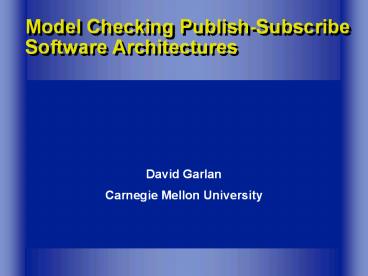Model Checking PublishSubscribe Software Architectures - PowerPoint PPT Presentation
Title:
Model Checking PublishSubscribe Software Architectures
Description:
Self-configuring systems. Carnegie Mellon: The Rare Glitch Project 4 ... Lots of inherent non-determinism. Order of invocation of multiple event recipients ... – PowerPoint PPT presentation
Number of Views:34
Avg rating:3.0/5.0
Title: Model Checking PublishSubscribe Software Architectures
1
Model Checking Publish-Subscribe Software
Architectures
- David Garlan
- Carnegie Mellon University
2
Research Approach
- Specification and analysis of software
architectures - Components and their interactions
- Architectural styles (e.g., client-server,
pipe-filter, publish-subscribe) - Architectural frameworks (e.g. for specific
domains and product lines) - Why?
- Architectural design is a critical design
artifact - Can explore system properties before
implementation - A good level of abstraction for reasoning about
system properties -- especially quality
attributes - State of arch practice is informal - needs
formalism - Amortized effort when architecture used by many
systems
3
Specific Thrusts
- Past research
- Specification languages for software architecture
- Wright -- based on CSP
- Analysis of specific architectural frameworks
- High-level architecture for distributed
simulation - Enterprise JavaBeans
- JavaPhone
- Tools for software architects
- Current research
- Specification and analysis of publish-subscribe
software architectures (todays talk) - Compositional mechanisms for component
interactions - Self-configuring systems
4
Publish-Subscribe Architectures
- An architectural style
- components objects, processes, functions
- connectors event registration
- computational model event announcement triggers
invocation of the zero or more methods/tasks that
are registered for that event - Features
- Anonymous multi-cast supports decoupling between
components - Hence easy to modify and maintain
- Widely used
- UIs, Prog envts, JavaBeans, Visual Basic, JINI,
CORBA, robots - Many variants
- synch/asynch, dispatch policies, concurrency,
shared state
5
Examples
- Set-Counter
- Set (S) has operations insert/delete
- Counter (C) has operations inc/dec
- Establish invariant S C
- Distributed Simulation (HLA)
- Arbitrary number of simulations publish values of
objects that they simulate - Run-time infrastructure (RTI) maintains state
(e.g.,ownership of objects), mediates protocols
of interaction - Many invariants (e.g., each object is owned by a
single simulation)
6
More Examples (State-based duals)
- Shared-variable triggered systems
- Aka continuous query systems
- State changes trigger computations
- Components read/write shared variables, but are
otherwise independent - Real-time periodic tasks
- Tasks placed in periodically-scheduled buckets
- Tasks consume values of certain variables
produce values of other variables - Tasks within bucket must completebefore bucket
period
7
Pub-Sub Systems are Hard to Reason About
- Burden of correctness falls to system integrator
- Lots of inherent non-determinism
- Order of invocation of multiple event recipients
- In-transit events
- Non-determinism in dispatch mechanism
- Questions that are hard to answer
- What do we want to say about such systems? Whats
an invariant? - Do the components announce the events that they
should announce? - What will be the effect of announcing a
particular event? - Are there the correct event subscriptions?
- If a new component is added, will it break what
is already there?
8
Technical Approach - Foundations
- Key ideas
- Events have semantics
- Explicit specification of non-interference
conditions - Compositionality via component environment specn
- Rely-guarantee verification framework
- Joint work with Juergen Dingel, Somesh Jha
Din98b - Based on Jones rely-guarantee approach
- Results It works, but is hard to use, and often
requires stronger invariants than are necessary - Temporal logic verification framework
- Explicit modeling of dispatcher Din98a
- Properties expressed in LTL
- Results Properties are more naturally expressed
9
Technical Approach - Tools
- Features
- Based on (LTL) foundations mentioned earlier
- Specifications translated to Cadence SMV Model
Checker input - Attempts to reduce cost of (a) building a system
model and (b) specifying the properties to check - Provides a Parameterized Model Generator
- Supports certain Built-in Checks
- Currently in early stages of development and
experimentation
10
Parameterized Model Generator
- Generate most of the run-time event delivery and
dispatch mechanisms - Greatly reduce cost of constructing model for
pub-sub systems - Support common dispatcher alternatives
- Allow easy exploration of alternatives
- Delivery options
- Asynchronous immediate return from announcement
- Synchronous return after event completely
processed - Concurrency options
- Single thread per component
- Multiple threads per component
- Dispatch order
- FCFS, Prioritized, Lossy, etc.
11
Model Architecture
Environment (external event source)
Event Announcement
DeliveryPolicy
Dispatcher
Data Exchange
Event Delivery
Shared state
12
Shared
13
Built-in Checks
- Provide many of the common sanity checks
- Move towards push-button tools
- Special cases
- Model-view topology
- UI event model
- Idempotent systems
- Procedure call pairs
- General consistency/completeness checks
- Components respect event semantics
- Events that are published, but not subscribed to
- Events that are subscribed to, but not published
- Liveness properties
- Race conditions
14
Next Steps(and opportunities for collaboration)
- Tool development
- More built-in checks, parameterization options
- Alternative model-checker substrates
- Applications
- Realistic problems
- Pub-sub bridges
- Current plan is to work on part of NASA remote
agent architecture - Better linkage to code
- Auto generation of component models?
- Counterexample explanation
- New specification capabilities
- Dynamism, timing, real-time
15
More information
- ABLE Project web site www.cs.cmu.edu/able
- Papers
- All98 Formal Modeling and Analysis of the HLA
Component Integration Standard. R. Allen, D.
Garlan, and J. Ivers. Proc of the 6th
International Symposium on the Foundations of
Software Engineering (FSE-6), Nov 1998. - Din 98a Reasoning About Implicit Invocation. J.
Dingel, D. Garlan, S. Jha, and D. Notkin. Proc
of of the Sixth International Symposium on the
Foundations of Software Engineering (FSE-6), Nov
1998. - Din 98b Towards a Formal Treatment of Implicit
Invocation using Rely/Guarantee Reasoning," J.
Dingel, D. Garlan, S. Jha, and D. Notkin. Formal
Aspects of Computing 10, 1998.































